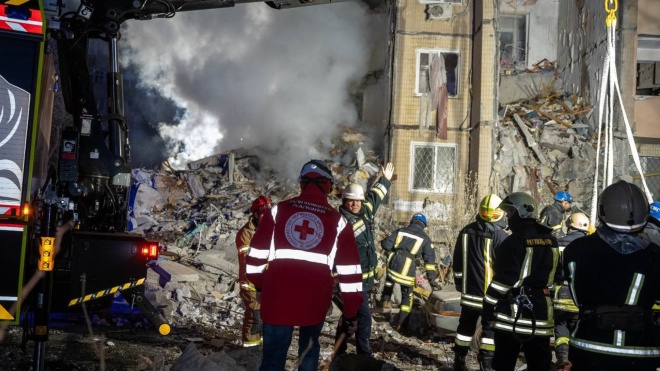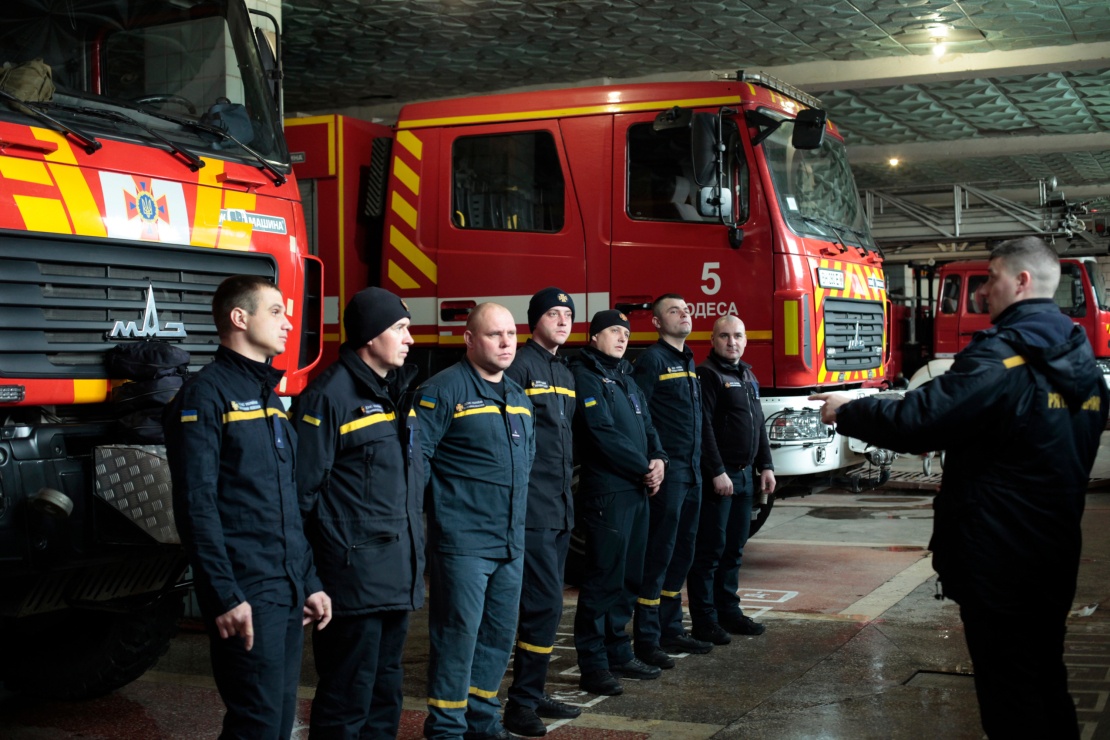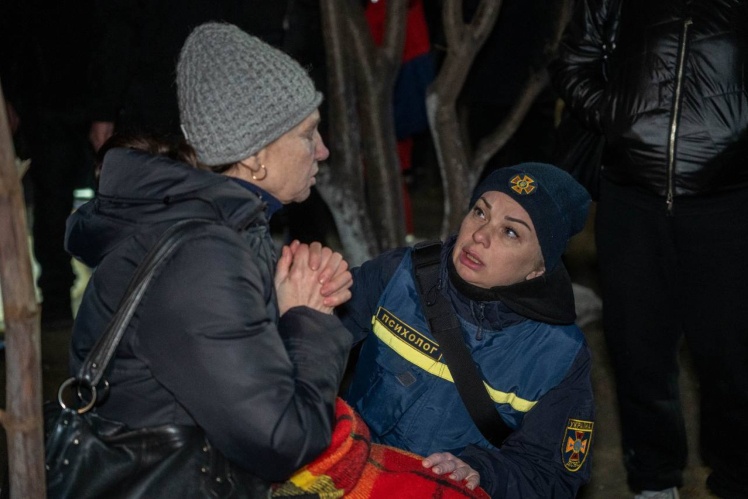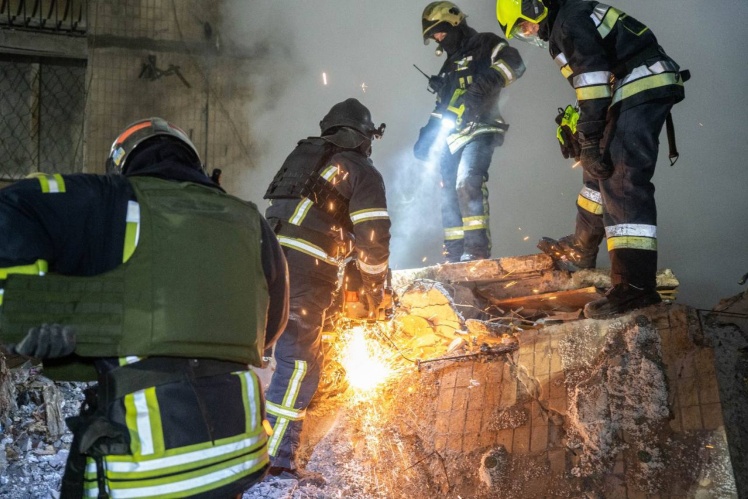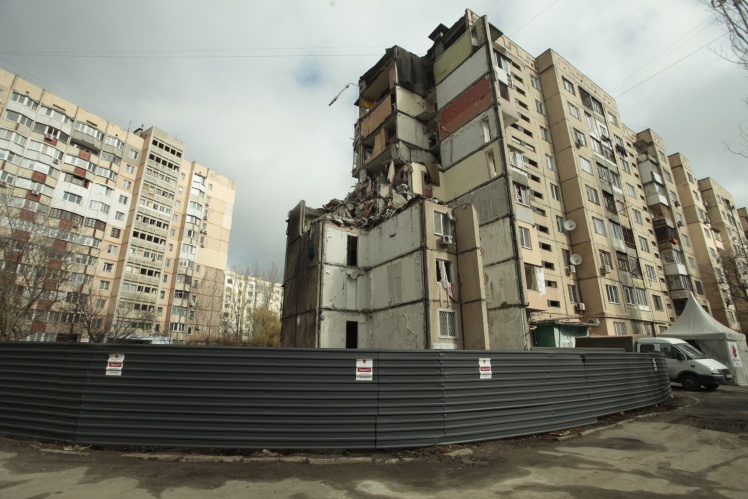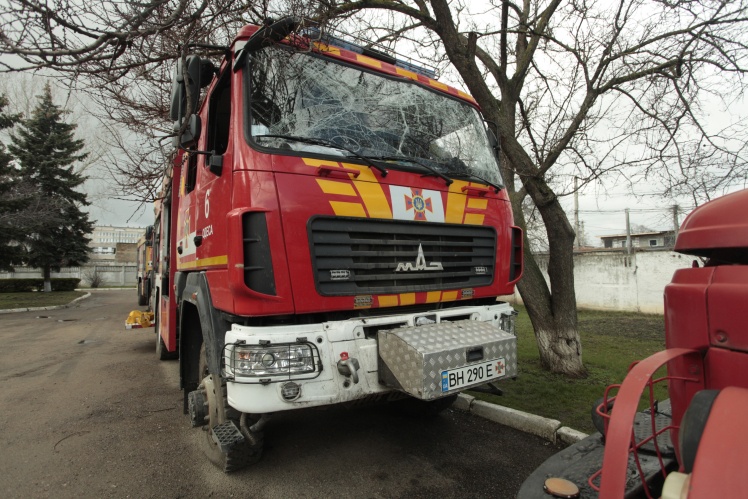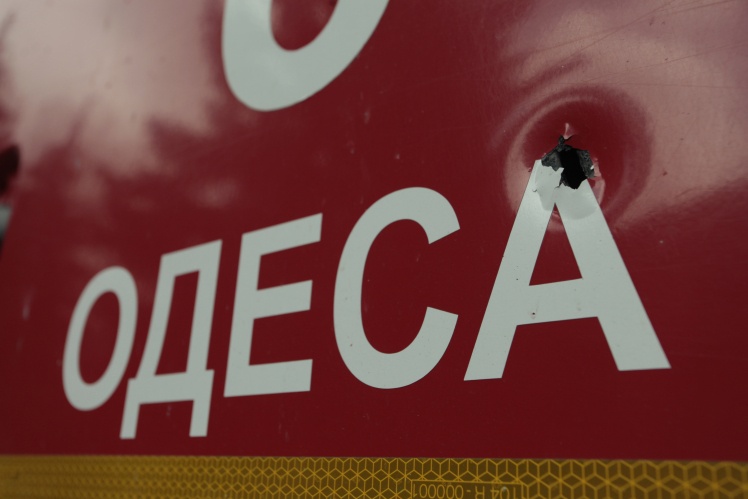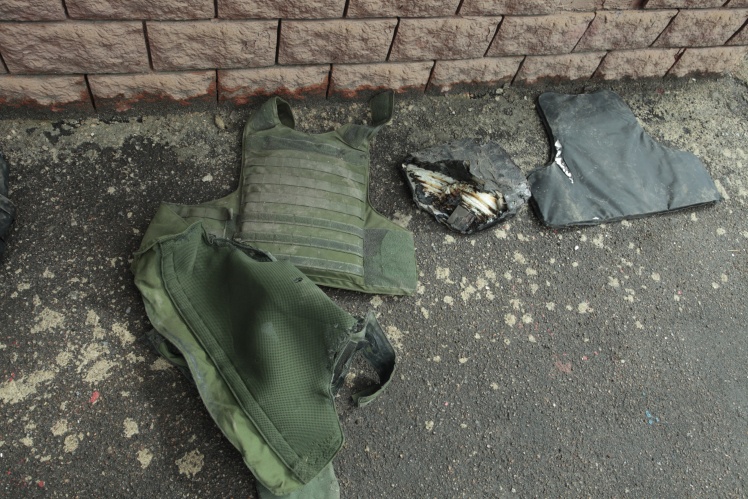1.
On the night of March 2, Dmytro Popov, the deputy chief of the fifth fire station in the Odesa neighborhood of Selyshche Kotovskoho, was on duty. Around 00:35, an air raid alarm sounded in the city. Dmytro led his rescue squad into the bomb shelter. A group of several Shahed drones was on its way to Odesa. Locals are used to this — since the second half of February, the Russians launch them almost every night.
Rescuers of the fifth fire department of Odesa.
Сергій Поляков / «Бабель»
Around one oʼclock in the morning, Dmytroʼs girlfriend, who also lives in Selyshche Kotovskoho, heard a loud explosion. She works as a paramedic at the local emergency room, so she was waiting to be called to the scene. Dmytro himself at the same moment received a message from the dispatcher that the drone had hit a house on Dobrovolskoho Avenue.
"When I was driving, I didnʼt think there would be such destruction," Dmytro recalls. He is tall, with dark short hair, answers monosyllabically, calmly and clearly, although he later admits that it was that hit that became the most difficult for him morally. He has been working as a rescuer since 2017.
Dmytro Popov in an apartment damaged by a drone strike on March 2, 2024.
Сергій Поляков / «Бабель»
The drone completely destroyed one of the houseʼs entrances. People who were sleeping in the house heard a loud explosion and immediately saw a fire glow. They ran outside to help the victims. When rescuers arrived at the scene, there were already many people there. Most of them were half-dressed — the impact caught them in their beds.
"There was a lot of panic," recalls Dmytro. “People tried to help, but in reality they only messed around. I had to shout to calm everyone down.”
Employees of the State Emergency Service work at the site where a Russian drone hit a high-rise building on March 2, 2024.
ДСНС України / «Бабель»
For a moment, Dmytro saw a woman under the reinforced concrete slab. She was lying with her head down, but she was conscious. The woman fell from the seventh or eighth floor and miraculously survived. She was picked up by an ambulance — the same ambulance where Dmytroʼs girlfriend works as a paramedic.
The rubble needed more than a day to be dismantled. On the morning of March 3, rescuers tried to get a woman out from under the slabs and noticed a baby next to her, which she was covering with her hand. The woman is military servicewoman Tatiana Kravets, and the baby is her eight-month-old daughter Yelyzaveta. They, Tetyanaʼs husband Oleg and two more of their children died. They were buried on March 5. All in snow-white coffins.
Rescuers pulled out five people alive from under the rubble. Twelve people died, five of them were children.
2.
On March 21st, the damaged house looks much the same as it did the night after the attack. Around the fence — it is dangerous to get close, the slabs can still collapse. In one of the apartments, almost intact interior door can be seen, in the other — an intact washing machine. Not far from the house is an improvised memorial with a bunch of flowers and childrenʼs toys. An elderly woman is crying near the ruins. Her house is opposite the destroyed one.
“When will it all end, daughter?”, she cries and asks the spokeswoman of the Odesa State Emergency Service Maryna Averina, who came with us. Instead of answering, she hugs her.
A ruined building on Dobrovolskoho Avenue in Odesa. Memorial to those killed on the night of March 2, 2024.
Сергій Поляков / «Бабель»
The entrance, Dmytro explains, collapsed from the impact, and all the slabs fell into the basement. If people were hiding there, they would die. But the homeless man, who was sleeping in the basement during the explosion, survived. Dmytro says heʼs lucky, because Soviet panel houses are real traps for residents. They usually collapse like a house of cards when hit. Hiding in such houses in a bathroom or a hallway doesnʼt really make sense. The rule about safer lower floors also does not work. In this house, the girl from the upper floor survived, and those who were below died.
“In new houses there are more chances to be saved,” says Popov. “They are usually monolithic, so they better withstand the impact. Panel houses, khrushchevkas or houses of the old Odesa are the most dangerous places.
On the first floor is the semi-survived apartment of Serhii and Anna Haydarzhy. Anna and her four-month-old son Tymofiy died in their sleep. They were found under the slabs in each otherʼs arms. Serhii miraculously survived — he went to another room, where the eldest daughter could not fall asleep, and stayed there. The girl was also saved.
One wall in the apartment is missing, but in some places the windows have survived. Books are scattered on the floor — a collection of the Russian poet Alexander Pushkinʼs poems and the seventh part of the Harry Potter saga. Broken dishes are mixed with concrete dust, in the corner there are whole three-liter cans of canned food.
A book in a destroyed apartment.
Сергій Поляков / «Бабель»
“You look at how a crane collects all human property, and you think: people lived here, hoped for something, bought something. And it all ended in one night,” says Dmytro.
Dmytro dreamed of becoming a rescuer from his youth, so in 2012 he entered the fire academy in Cherkasy, central Ukraine. But, of course, he did not think about the war. He recalls that on the morning of February 24, he, like all other Odesa rescuers, was urgently called to the office. It is located almost outside the city, so they had to drive through traffic jams on country roads. Missiles were flying over Odesa at that time.
Dmytro is already used to working in the war. Because of it, his work has changed a lot: if before the rescuers worked more on fires, now they get people out from under the rubble. Sometimes dogs are used for this, but most often the rescuers just focus on the sound. A so-called minute of silence is announced once an hour — without it, it is difficult to hear people calling for help due to shouts and the operation of equipment.
“If a person can move under the rubble, he or she have to knock on the slabs,” explains Dmytro. “Or shout. But in reality, more often than not, we make our way blindly. First, we turn over the slabs with our hands, if there is a suspicion that someone is alive there.
It is not possible to use special equipment while there are people under the rubble. It is involved only at the last stage. The most difficult thing is to get the dead.
"We worked on Dobrovolskoho Avenue for several hours until help arrived," recalls Dmytro. “I told my boys to get some rest, and he himself got into the car. I sat for literally five minutes, and they told me that they had found the first corpse. I immediately got up and went to work. I couldnʼt sit still, I thought that there were people there, maybe it would be possible to get someone alive.”
Sport somehow helps Dmytro to cope with his experiences. He says that he vents all his anger during training — he does boxing.
"We learned to help people," shrugs the rescuer. “There is more work, we are constantly on the phones, but we knew what we were going for.”
Rescue workers, who on March 2 were sorting out rubble on Dobrovolskoho Avenue.
Сергій Поляков / «Бабель»
3.
Oleg Kotelevskyi is the chief of the sixth fire station in the Kyiv district of Odesa. He dreamed of becoming a rescuer from an early age and, like Popov, graduated from the fire academy in Cherkasy — in 2010. Since then, he has been working in Odesa in the same unit, first as a rescuer, and in 2019 he headed it.
"This is how I remember my first fire," says Kotelevsky. He is short, with short blond hair, and when he speaks, heʼs a little nervous: publicity is unusual for him. “Fourteenth floor, open flame. We couldnʼt even approach the corridor [in the apartment] — due to the high temperature, the visors of the firemenʼs helmets melted. We didnʼt have mobile ladders then, so we used ropes to descend from the fifteenth floor.
Oleg Kotelevskyi.
Сергій Поляков / «Бабель»
Kotelevskyi also remembers his first flight in April 2022 in detail.
"Then the management explained to us — if you come under fire, the first thing to do is look for a concrete wall and hide behind it," says the rescuer. “But we arrived in an open area, it was the first line near the sea — that is, almost a beach. There are no walls there — just a metal fence stitched with debris. And then we were warned that now there will be a second hit and we have to leave from there. My driver, Serhiy, was driving backwards — his mirrors were folded down, he could not see anything, but we had to move away very quickly.”
Kotelevskyi calls his unit a combat one. The Kyiv district of Odesa city, he says, during the two years of the full-scale war, the Russians hit the most. While we are talking in the unit, shooting is also heard in the background — it is Odesa air defense shooting down reconnaissance drones. Despite active shelling, the unit held out without losses for a long time — until March 15.
Work uniform of rescuers. Combat deployment takes one minute.
Сергій Поляков / «Бабель»
That day, around 11 oʼclock in the afternoon, an alarm sounded in Odesa. Two divisions of the sixth fire department — ten men in all — drove to the bomb shelter nearby in two cars, but did not have time to get there. The dispatcher reported that a missile hit the building on Dacha Kovalevskoho Street, 20. All ten went to the place. Behind them in his own car was Kotelevskyi with a driver. He leaves every time if there are victims at the place of the hit.
"Since the cars were driving with beacons, they were allowed to pass," says Kotelevskyi. “They arrived faster and have already started working. We were about five minutes behind. And when we were not far from the place [of the hit], we heard a second explosion.”
Kotelevskyiʼs car was riddled with debris, it stalled. Together with the driver, he ran to the place of hit. From afar, he saw that two of his rescuers, Denys Kolesnikov and Mykola Stadnyk, lying on the road.
"I ran up to Kolesnykov, saw that he was unconscious," Kotelevskyi recalls. “I called a doctor, he started giving him artificial respiration. And I was told to take off his outer clothes. I cut through the armor and saw that he had a side wound to the chest and the blood was flowing without stopping.”
Then Kotelevskyi ran up to Stadnyk. He was conscious, said that he could not feel his legs. Rescuer Artem Augustynovych had a burnt face. He sat leaning against a tree. Kotelevskyi ran further — he saw another rescuer with a wounded leg.
“I ran up to everyone, asked: ʼHow are you? Can you move? Then get up, help ours," continues Kotelevsky. “Our young boy, the chief of the fourth guard, Mykola Malyshenko, shouted: "This cannot happen."
“Their arms and legs were broken, but they still dragged the boys,” adds Maryna Averina, spokeswoman for the Odesa State Emergency Service. “And then, when help had already arrived, they all fell to the ground.”
Artem Augustynovych (center) with his face burned at the site of a rocket impact in Odesa on March 15, 2024. Rescuers carry out colleagues who were hit.
ДСНС України / «Бабель»
When the ambulances were already taking away the wounded, Oleksandr Krytskyi, the deputy chief of the Main Directorate of the State Emergency Service in the Odesa region, approached Kotelevskyi and asked if he knew where all the personnel were. Kotelevskyi replied that he handed everyone over to the ambulance.
“And then he asks: "And who is the person lying here then?", recalls Kotelevskyi. “I saw my Kolesnykov, there were no more tears. I was sure that everyone was alive and everyone was taken away by an ambulance. Because I myself transferred Kolesnykov [to the ambulance]. But he died and was taken out and laid on the ground. To leave room for the living.”
The next day, the second rescuer, Vitaliy Alimov, died in the hospital. In total, 20 people died from the Russian attack.
4.
We meet with Kotelevskyi in his unit on March 21 — almost a week after the tragedy. Protective plate carriers and fire helmets pierced by rocket fragments lie in the yard.
Kotelevskyi shows the car he was driving: two holes in the roof and headlight from debris. He was lucky twice — first, when he was late for the second shelling, the second time — when he did not die from the debris. One of them entered the car exactly where Kotelevskyi was sitting, but got stuck in the back.
Damaged fire trucks after the impact on March 15, 2024.
Сергій Поляков / «Бабель»
"It was going straight to him," says the driver, who was driving at the time, and nods at Kotelevskyi.
He takes us to the backyard of the unit, where there are fire trucks that were working on March 15. Both are heavily damaged. Kotelevskyi points to the frame — itʼs made of very strong metal, but even it is stitched with fragments.
“The explosion was specifically designed to hurt more people. Because there were a lot of wreckage,” Kotelevskyi explains.
Punctured plate carriers and fire helmets of rescuers who were affected by the impact on March 15, 2024.
Сергій Поляков / «Бабель»
Lifeguards smoking in the yard are quiet and gloomy. The spokeswoman of the Odesa State Emergency Service Maryna Averina says that the team of this unit is very friendly. At the funeral of Denis Kolesnykov and Vitaliy Alimov, everyone cried. Photos of the dead rescuers are on the table in the room of the unit, next to them are a few carnations and a childrenʼs letter. In capital letters it is written: "We love you, our heroes."
Photo of the rescuers killed in the March 15, 2024 strike.
Сергій Поляков / «Бабель»
“The boys are still in shock. They cannot get through this,” says Averina.
Denys Kolesnykov and Vitaliy Alimov were friends. Kolesnykov was 29 years old, Alimov was 39. Both lived near Bilhorod-Dnistrovsky and went to Odesa for work together. Both came to the unit as rescuers, but later became drivers.
"They were two good guys," says Kotelevskyi.
Another six of his subordinates remain in hospitals. They are waiting when they can return to the service.
"Yesterday I came to Dontsov," says Kotelevsky, and for the first time during the conversation he becomes a little more cheerful. “He told me: ʼThe last thing I remember is a girl from the press service taking a picture of me. I also thought that I should get her phone number. And switched off."
During the two years of the full-scale war, no one left the unit. On the contrary, the number of people willing to work as rescuers has increased. Kotelevskyi says that now he loads people more with work so that there is less time for thinking. He persuades them not to blame themselves for the death of their friends. Although he himself admits that March 15 is still in front of his eyes. The fourth rescue unit is his family, he started as a rescuer in it. Of the veterans of this unit, only he and Mykola Stadnyk, who is now in the hospital, remained there.
"Whatever grief we have in our hearts, this is our job," says Kotelevsky. “The boys say that it is easier for them to worry in the team than at home.”
Сергій Поляков / «Бабель»
Translated from Ukrainian by Anton Semyzhenko.
The Ukrainian army saves our lives. Support Come Back Alive Foundation.
